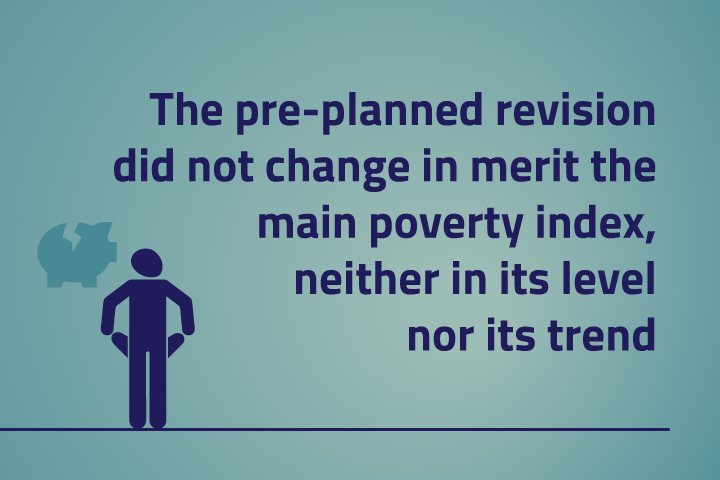Living conditions
The living conditions and living standard of the population can be represented, among other things, by the indicators of poverty, social exclusion, income situation by social strata, data on consumption. Size and composition of households, families belong here, too.
Key figures
Relative at-risk-of-poverty rate
Indicator description
Share of persons living in households with an income below 60 % of the median equivalised income. Median equivalised income: after ranking the total population on the basis of the income per OECD 2 consumption unit, the median income is in the middle of the line, i.e. the number of population with less and that of population with more income is the same.
Source of data:
Summary Tables (STADAT)
Last data for period: 2024
Severe material and social deprivation rate
Indicator description
Severe material and social deprivation refers to persons who experience at least seven of the thirteen problems listed below: cannot afford
- a week of holiday away from home annually,
- to face unexpected expenses,
- to eat meat, fish or a protein equivalent every second day,
- to avoid arrears (in mortgage/house loan, rent, utility bills and/or hire purchase instalments),
- to keep home adequately warm,
- have access to a car/van for personal use,
- to replace worn-out furniture,
- to replace worn-out clothes with new ones,
- having two pairs of properly fitting shoes (including a pair of all-weather shoes),
- to get together with friends/family for a drink/meal at least once a month,
- to have regular leisure activities,
- to spend a small amount of money each week on themselves (pocket money),
- having an internet connection.
Source of data:
Summary Tables (STADAT)
Last data for period: 2024
Share of people living in households with very low work intensity
Indicator description
Share of people living in households where people of working age (aged 18–64) work less than 20% of their total work potential during the past year.
Source of data:
Summary Tables (STADAT)
Last data for period: 2024
Share of people at risk of poverty or social exclusion
Indicator description
Share of people within the total population who are affected by at least one of the followings: at-risk-of-poverty, severe material and social deprivation or living in households with very low work intensity.
Source of data:
Summary Tables (STADAT)
Last data for period: 2024
Featured
Snapshots, 2024 – The living standard of households
Gross yearly income per capita in Hungary was 3 million 673 thousand HUF in 2024, the net yearly income per capita amounted to 2 million 797 thousand HUF, the former increasing by 12.2%, the latter by 13.6% year-on-year. At the same time the income of the richest people grew faster than that of the poorest, the relative condition of the latter got worse as a result. The number of people at risk of poverty or social exclusion stagnated in 2024 year-on-year, with 1 million 819 thousand people in the affected group.
Hungary in figures, 2023 – Highlighted data
At the aid of our infographic made using the main data in our publication titled Hungary in figures, 2023, we give a comprehensive picture of the socio-economic state of Hungary. There were 1,073 females per thousand males in Hungary at the beginning of 2024. Life expectancy at birth rose to the highest level yet in 2023 (to 73.4 years for males and 79.6 years for females). Over a quarter of manufacturing output was made up by the manufacture of transport equipment.
Yearbooks, pocketbooks, data repositories
A new sub-page has been added to the HCSO website, more than 400 yearbooks, pocketbooks and data collections, a total of a hundred thousand pdf format pages close to 150 thousand excel tables and several thousand static and interactive graphs and maps are available for download. The sub-page offers the possibility of filtering these yearbooks, pocketbooks and data collections by reference year, serial name, format (PDF, XLS) and supplements (graphs, maps). Users may compile their own list of publications based on the year- and pocketbooks, data collections, adequate to their interests.
Hungary 2024 – The Living Conditions
Our series of infographics, based on the most important data from the Hungarian-language publication Hungary, 2024 provides a comprehensive picture of the social and economic state of our country and the main characteristics of our environment. The next infographic in the series presents the main data of the living conditions. The English extract from the publication is available here: Hungary, 2024, and the full Hungarian-language version here: Magyarország, 2024.
Hungary, 2024
Hungary’s GDP increased by 0.5% amid global challenges in 2024. The performance of goods-producing industries lessened, while that of service-providing ones rose, which shows the duality of economic trends. Household consumption picked up, which was considerably encouraged by the purchasing power of earnings growing again with the inflationary wave calming down. Besides, the data series reveal that the level of employment reached another peak.
On-line purchases
Based on international trends, the popularity of purchases on the internet rapidly increases in Hungary as well, more and more people recognise its advantages and take advantage of this. 56% of households placed an order on-line in the 4th quarter of 2024, and they spent an average 84.7 thousand forints in making purchases on the internet. E-buyers most often purchased articles of clothing and shoes (64%), which was followed by electrical goods (48%), the administration of overheads payments, and of various finances (42%), as well as the order of household equipment (31%).
Easter preparations
Easter is the most important celebration in Christianity, a symbol of rebirth and hope. Easter traditions include egg painting, water sprinkling and family gatherings with typical dishes such as ham and kolach (traditional sweet bread). The celebration has not only religious but also cultural significance, intertwined with the spirit of spring renewal.
Environmental habits of households
The HCSO conducted, for the first time, an experimental survey in 2023 on environmental habits of households. The questionnaire aimed to learn about households’ approach to environmental issues. The problems posing the most serious threat deemed to be the growing amounts of waste and the low rate of public transport use. Composting is widespread in municipalities and other towns, not so much in towns of county rank and Budapest. 41% of households purchased environmentally friendly products on a regular basis in 2023, families with children are more willing to buy environmentally friendly products.
Related themes
- Housing
- Income and consumption
- Men and women
- Population and vital events
- Social care protection
- Time use
- The young and the elderly




















